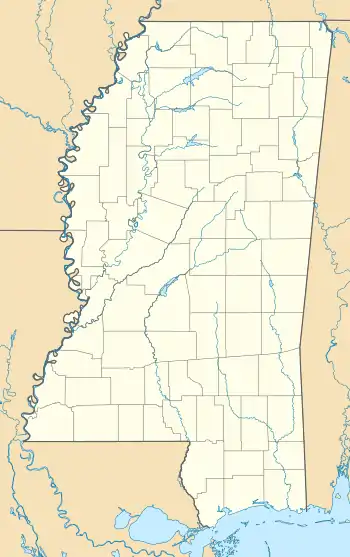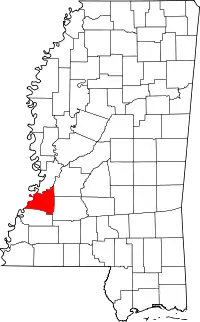Bruinsburg, Mississippi
Bruinsburg is a ghost town in Claiborne County, Mississippi, United States.[1]
Bruinsburg, Mississippi | |
|---|---|
Ghost town | |
.jpg.webp) 1840 map of Mississippi River showing Grand Gulf, Bruinsburg, and Rodney | |
 Bruinsburg Location of Bruinsburg  Bruinsburg Bruinsburg (the United States) | |
| Coordinates: 31°56′33″N 91°09′26″W | |
| Country | |
| State | |
| County | Claiborne |
| Elevation | 24 m (79 ft) |
| Time zone | UTC-6 (Central (CST)) |
| • Summer (DST) | UTC-5 (CDT) |
| GNIS feature ID | 691732[1] |
It was located on the south bank of Bayou Pierre, 3.0 mi (4.8 km) east of the Mississippi River. The town's port, Bruinsburg Landing, was located directly on the Mississippi River, just south of the mouth of the Bayou Pierre.
Once an important commercial and military location, nothing remains today of the town or its port.[2]
History
Bruinsburg is named for Peter Bryan Bruin, who emigrated from Ireland to Virginia in 1756, and later fought as a lieutenant during the American Revolution. Following the war, Bruin's father received 1,200 acres (490 ha) of land in Mississippi in a grant from Don Diego de Gardoqui, a Spanish minister who controlled the region. Peter Bruin's family, along with 12 other families, moved there in 1778.
The land grant required the settlers to survey the land, clear trees, build cabins, and plant crops. The settlers were soon growing corn, cotton, tobacco, indigo, fruits and vegetables.
After the southern United States became an American possession, Bruin was appointed a judge. In 1807, former Vice-President Aaron Burr, who at the time was wanted on a charge of treason, visited Bruin while fleeing federal agents.
Lake Bruin, an oxbow lake in Louisiana west of Bruinsburg, is named for Peter Bruin.
The community was a lively Mississippi River port, and future U.S. President Andrew Jackson set up a trading post there for a time.[2]
Civil War
Union Army General Ulysses S. Grant was planning a massive assault on the Confederate stronghold of Vicksburg, Mississippi. After having failed to land his army at Grand Gulf, Mississippi, he arrived on April 29, 1863, at Disharoon's Plantation in Louisiana, about 5 mi (8.0 km) north of Bruinsburg on the opposite bank of the Mississippi River. Grant made a plan to land his troops at Rodney, Mississippi, about 12 mi (19 km) downstream, until late that night, an escaped slave told Grant about the much nearer port of Bruinsburg, which had an excellent steamboat landing, and a good road ascending the bluffs east of the river.
The following day, 17,000 Union soldiers began landing at Bruinsburg, marking the beginning of the Battle of Port Gibson, part of the larger Vicksburg Campaign. Because river traffic had diminished through the war, when the soldiers arrived at Bruinsburg the port was nearly deserted, and the sole witness to the invasion was a farmer who appeared too confused to flee. The port proved to have a good solid bank, and space for many boats. It was the largest amphibious operation in American military history until the Allied invasion of Normandy.
When this was accomplished I felt a degree of relief scarcely ever equaled since. Vicksburg was not yet taken it is true...but, I was on dry ground on the same side of the river with the enemy.
The soldiers moved east along the dusty wagon trails from Bruinsburg, and then rested under the trees of the nearby Windsor Plantation. That evening, they began their march north.
By 1865, the town was extinct.
The former town and its landing are now located on private property. A historic plaque commemorating Bruinsburg is located on Church Street in Port Gibson.[2][4][5][6]
References
- "Bruinsburg, Mississippi". Geographic Names Information System. United States Geological Survey, United States Department of the Interior.
- Weiser, Kathy (March 2012). "Bruinsburg to Port Gibson in the Vicksburg Campaign". Legends of America.
- Bearss, Edwin C. (2010). Receding Tide: Vicksburg and Gettysburg, the Campaigns that Changed the Civil War. National Geographic Books. ISBN 9781426205101.
- Grabau, Warren (2000). Ninety-Eight Days: A Geographer's View of the Vicksburg Campaign. University of Tennessee Press. ISBN 9781572330689.
- "Bruinsburg Crossing (April 30-May 1)". National Park Service. Retrieved November 14, 2016.
- "Bruinsburg". Markeroni. Archived from the original on March 11, 2016. Retrieved November 14, 2016.
